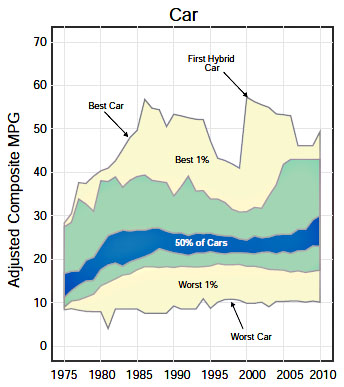 So how fuel efficient are modern passenger cars? Stuart Staniford passes along a link to the latest EPA mileage report, which both clarifies things and adds a bit to the murk.
So how fuel efficient are modern passenger cars? Stuart Staniford passes along a link to the latest EPA mileage report, which both clarifies things and adds a bit to the murk.
First the clarification. Table 1 in the report provides an “adjusted composite” figure of 25.8 mpg for model year 2010 cars. This number is production weighted, so it reflects the actual distribution of cars sold.
But wait! For the past decade the EPA report has published “adjusted” — i.e., real world — numbers because the “laboratory” EPA mileage, which is the number you see on a car’s sticker, is notoriously over-optimistic. For 2010, the average laboratory 55/45 combined mileage was 32.7, which kinda sorta explains the BTS figure of 33.7 from the previous post. Close enough for government work, anyway. (Though this still sounds pretty high to me. It’s based on average city mileage of 27.6 and average highway mileage of 42.3, but according to DOE’s search site, there were a grand total of eight cars in 2010 that got lab EPA highway mileage over 42 mpg. So it’s hardly credible that the fleet highway average was 42.3 even using the lab EPA values.)
So I’m still a little confused. Still, if you’re looking for a real-world, production weighted fleet average for gas mileage, the best current estimate is 25.8 mpg for model year 2010. Now you know.















